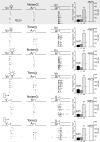Incorporating cross-modal statistics in the development and maintenance of multisensory integration
- PMID: 22396404
- PMCID: PMC3561931
- DOI: 10.1523/JNEUROSCI.4304-11.2012
Incorporating cross-modal statistics in the development and maintenance of multisensory integration
Abstract
Development of multisensory integration capabilities in superior colliculus (SC) neurons was examined in cats whose visual-auditory experience was restricted to a circumscribed period during early life (postnatal day 30-8 months). Animals were periodically exposed to visual and auditory stimuli appearing either randomly in space and time, or always in spatiotemporal concordance. At all other times animals were maintained in darkness. Physiological testing was initiated at ∼2 years of age. Exposure to random visual and auditory stimuli proved insufficient to spur maturation of the ability to integrate cross-modal stimuli, but exposure to spatiotemporally concordant cross-modal stimuli was highly effective. The multisensory integration capabilities of neurons in the latter group resembled those of normal animals and were retained for >16 months in the absence of subsequent visual-auditory experience. Furthermore, the neurons were capable of integrating stimuli having physical properties differing significantly from those in the exposure set. These observations suggest that acquiring the rudiments of multisensory integration requires little more than exposure to consistent relationships between the modality-specific components of a cross-modal event, and that continued experience with such events is not necessary for their maintenance. Apparently, the statistics of cross-modal experience early in life define the spatial and temporal filters that determine whether the components of cross-modal stimuli are to be integrated or treated as independent events, a crucial developmental process that determines the spatial and temporal rules by which cross-modal stimuli are integrated to enhance both sensory salience and the likelihood of eliciting an SC-mediated motor response.
Figures









Similar articles
-
Cross-Modal Competition: The Default Computation for Multisensory Processing.J Neurosci. 2019 Feb 20;39(8):1374-1385. doi: 10.1523/JNEUROSCI.1806-18.2018. Epub 2018 Dec 20. J Neurosci. 2019. PMID: 30573648 Free PMC article.
-
The normal environment delays the development of multisensory integration.Sci Rep. 2017 Jul 6;7(1):4772. doi: 10.1038/s41598-017-05118-1. Sci Rep. 2017. PMID: 28684852 Free PMC article.
-
Initiating the development of multisensory integration by manipulating sensory experience.J Neurosci. 2010 Apr 7;30(14):4904-13. doi: 10.1523/JNEUROSCI.5575-09.2010. J Neurosci. 2010. PMID: 20371810 Free PMC article.
-
Nonvisual influences on visual-information processing in the superior colliculus.Prog Brain Res. 2001;134:143-56. doi: 10.1016/s0079-6123(01)34011-6. Prog Brain Res. 2001. PMID: 11702540 Review.
-
The interactions of multisensory integration with endogenous and exogenous attention.Neurosci Biobehav Rev. 2016 Feb;61:208-24. doi: 10.1016/j.neubiorev.2015.11.002. Epub 2015 Nov 10. Neurosci Biobehav Rev. 2016. PMID: 26546734 Free PMC article. Review.
Cited by
-
Experience Creates the Multisensory Transform in the Superior Colliculus.Front Integr Neurosci. 2020 Apr 21;14:18. doi: 10.3389/fnint.2020.00018. eCollection 2020. Front Integr Neurosci. 2020. PMID: 32425761 Free PMC article.
-
Crossmodal plasticity in hearing loss.Trends Neurosci. 2023 May;46(5):377-393. doi: 10.1016/j.tins.2023.02.004. Epub 2023 Mar 27. Trends Neurosci. 2023. PMID: 36990952 Free PMC article. Review.
-
The influence of early audiovisual experience on multisensory integration and causal inference (commentary on Smyre et al., 2021).Eur J Neurosci. 2022 Jan;55(2):637-639. doi: 10.1111/ejn.15576. Epub 2021 Dec 29. Eur J Neurosci. 2022. PMID: 34939247 Free PMC article. No abstract available.
-
Training, hypnosis, and drugs: artificial synaesthesia, or artificial paradises?Front Psychol. 2013 Oct 14;4:660. doi: 10.3389/fpsyg.2013.00660. eCollection 2013. Front Psychol. 2013. PMID: 24133468 Free PMC article.
-
A learning-based approach to artificial sensory feedback leads to optimal integration.Nat Neurosci. 2015 Jan;18(1):138-44. doi: 10.1038/nn.3883. Epub 2014 Nov 24. Nat Neurosci. 2015. PMID: 25420067 Free PMC article.
References
-
- Bolognini N, Rasi F, Coccia M, Làdavas E. Visual search improvement in hemianopic patients after audio-visual stimulation. Brain. 2005;128:2830–2842. - PubMed
-
- Buonomano DV, Merzenich MM. Cortical plasticity: from synapses to maps. Annu Rev Neurosci. 1998;21:149–186. - PubMed
-
- Feldman DE. A new critical period for sensory map plasticity. Neuron. 2001;31:171–173. - PubMed
Publication types
MeSH terms
Grants and funding
LinkOut - more resources
Full Text Sources
Miscellaneous
